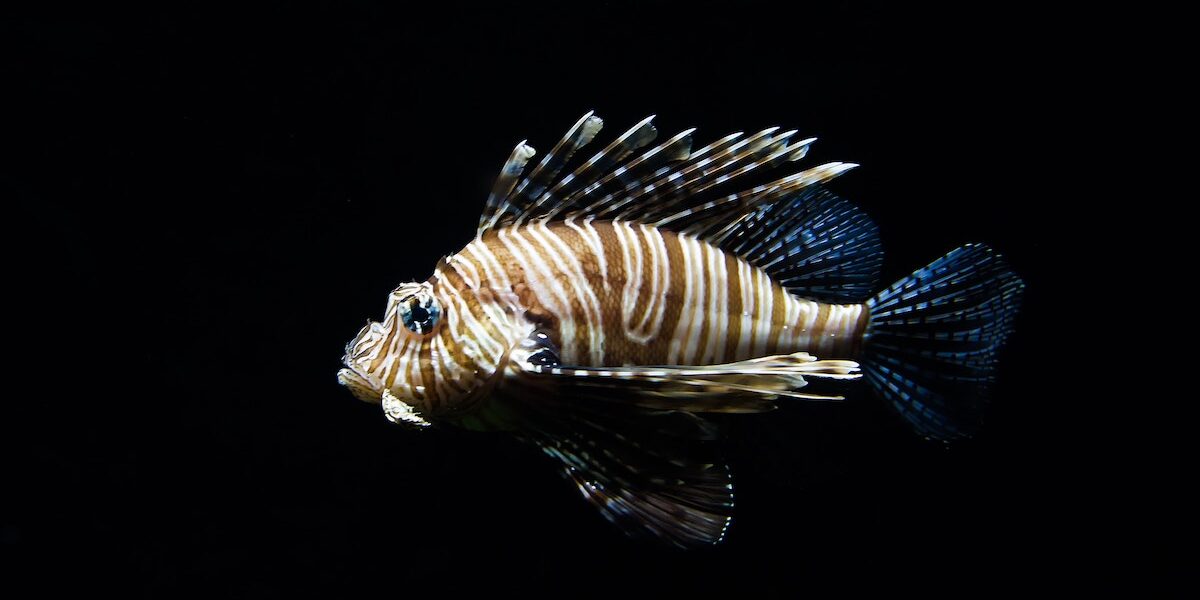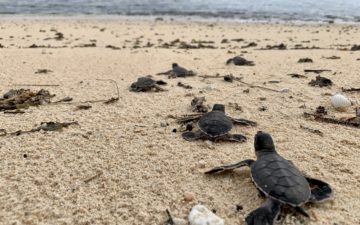By Laura Sesana
This article originally appeared on CDN
The Calvert Marine Museum in Solomons, Maryland will be educating museum goers about the dangerously invasive Lionfish that threaten Caribbean waters and reef systems. Lionfish are beautiful and exotic, but as an invasive species that is not native to the Atlantic, their rapid proliferation is could cause major environmental and economic problems. With long venomous spikes and flamboyant appearance, Lionfish are brightly colored and have dramatic fans of projecting venomous spines that make lionfish easily identifiable. Members of the genus Pterois, scientists have identified 10 different species of lionfish.
 Native to the South Pacific and Indian Oceans Lionfish grow between two to 15 inches in length. They are aggressive predators of small fish, shrimp, crabs and other small marine life, inhabiting the waters near coral reefs, rocky walls and lagoons. Lionfish have an average life span between five and 15 years and can reproduce monthly after their first year. Even though a lionfish sting may be extremely painful, causing difficulty breathing, nausea and vomiting, it is rarely fatal to humans. Their venom contains a combination of protein, a neuromuscular toxin and acetylcholine, a neurotransmitter.
Native to the South Pacific and Indian Oceans Lionfish grow between two to 15 inches in length. They are aggressive predators of small fish, shrimp, crabs and other small marine life, inhabiting the waters near coral reefs, rocky walls and lagoons. Lionfish have an average life span between five and 15 years and can reproduce monthly after their first year. Even though a lionfish sting may be extremely painful, causing difficulty breathing, nausea and vomiting, it is rarely fatal to humans. Their venom contains a combination of protein, a neuromuscular toxin and acetylcholine, a neurotransmitter.
Not native to the Atlantic Ocean, two species of lionfish—the red lionfish and the common lionfish—have flourished in the Caribbean and along the East Coast of the United States to the extent that they are now considered invasive species. Most researchers believe that lionfish initially entered the waters off the coast of Florida in the 1980s. Hurricane Andrew, in 1992, destroyed an aquarium on Biscayne Bay, releasing six lionfish into the open water. Lionfish have been detected as far north as North Carolina and as far south as Venezuela, and their range appears to be expanding. It appears that climate change may also be playing a role.
Lionfish have very few known natural predators, one of the main reasons why they have become a major problem in some areas in the East Coast and the Caribbean. Calvert Marine Museums hope to educate visitors on this invasive predator that threatens the fish that live in our warm waters, and how those warming waters are helping the Lionfish to thrive.
“We are refocusing our messaging to include impacts and potential impacts of climate change, one of the leading threats to the future sustainability of our world’s ecosystems,” explains David Moyer, Curator of Estuarine Biology at the Calvert Marine Museum in Solomons, MD.
“Lionfish are invading the Western Atlantic Ocean. During the summer, they make it as far north as New York, obviously transported through Maryland’s offshore marine habitat. As climate change brings warmer seawater temperatures to our region, and as sea level rise continues to intrude into Maryland’s coastal shallows, the potential for lionfish becoming established permanently in our waters increases,” wrote Moyer in a recent email.
Lionfish populations in these areas are quickly increasing. The National Centers for Coastal Ocean Science (NCCOS) estimates that in some waters lionfish densities have surpassed many native species. In several hot spots there are over 1,000 lionfish per acre.
Researchers do not know exactly how growing populations of lionfish will affect native fish populations and commercial fishing. They do know, however, that foreign species can have a severe effect on native ecosystems and local fishing economies. It is also known that lionfish prey on snapper and grouper, two commercially important species.
According to the National Oceanic and Atmospheric Administration (NOAA), lionfish can cause severe damage to reef communities by disrupting the delicate balance of certain ecosystems. As top predators, lionfish can reduce the number of prey and compete with native reef predators, subsequently taking over their role.
Researchers report that introduction of lionfish in some areas reduces the survival rate of native reef fish species by 80 percent, according to the U.S. Federal Aquatic Nuisance Species Task Force (ANS).
In areas where lionfish populations are becoming a problem, several control measures have been implemented from encouraging their consumption (lionfish are safe to eat if prepared correctly) to sponsoring fishing contests and allowing divers to kill lionfish in marine sanctuaries. Divers and fishermen are encouraged to report lionfish sightings, and dive operators are encouraged to remove the fish when possible.
However, it is not likely that lionfish will be completely eradicated from an area where they have established a population, according to NOAA, as control measures are likely to be too costly or complicated. NOAA predicts that lionfish numbers in the Atlantic are likely to increase.
Researchers recommend tracking lionfish populations, conducting more research, educating the public, and creating regulations about releasing non-native marine species as ways to slow down the spread of lionfish and other invasive species.
Several researchers and agencies emphasize education. “Modern invasive species problems are almost always associated with human activities,” says David Moyer. “While Man has already contributed significantly to the redistribution of all kinds of organisms throughout the world, ecological invasions are not over and there is potential for more invasive species to be introduced every day.”
In an effort to educate the public in the DC area, and thanks to generous contributions to the Estuarine Biology Department, the Calvert Marine Museum Solomons, MD will feature a lionfish aquarium in their Eco-Invaders section after upcoming renovations to the Estuarium.
“Including information about the current and future ecological invaders in our region will educate our guests about how invasive species are introduced and spread,” said Moyer in an email about the upcoming renovations to the Eco-Invaders exhibit. “Armed with this, more people will hopefully become aware of how their own activities and choices might impact their environment. Distribution of this information has the potential to help reduce future undesirable introductions.”
Laura Sesana is a writer and DC, MD attorney. Follow her on Facebook, Twitter @lasesana, and Google+.







